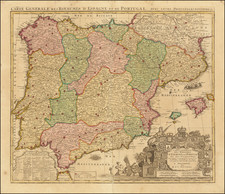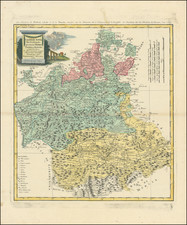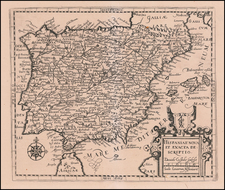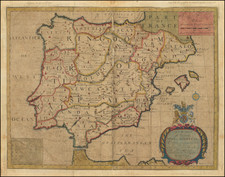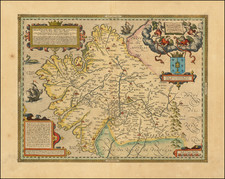A detailed rendering of the Spanish city, this map of Malaga is a noteworthy piece from Braun & Hogenberg's city atlas, created around 1572 in Cologne. With its intricate detail and captivating commentary, the map offers an informative glimpse into the urban life of 16th-century Malaga.
The map and its accompanying text reflect a city enriched by commerce, particularly in its well-regarded wines and decorated earthenware. Braun's commentary also highlights Malaga's strategic importance to the King of Spain, who maintained an arsenal in the city. These observations situate Malaga within the broader context of 16th-century Spanish trade and politics.
The geographical precision of the map is complemented by an elaborate cartouche text that provides a historical background of the city. It mentions Malaga's founding by the Phoenicians and its status as a significant bishopric, lending a sense of historical depth to the map.
Though originally part of a folio sheet featuring two more images, this single depiction of Malaga stands as an impressive piece of Braun & Hogenberg's cartographic oeuvre. Its blend of precise mapping, engaging commentary, and historical context makes it an informative artifact of 16th-century Malaga.
Georg Braun (1541-1622) was born and died in Cologne. His primary vocation was as Catholic cleric; he spent thirty-seven years as canon and dean at the church St. Maria ad Gradus, in Cologne. Braun was the chief editor of the Civitates orbis terrarum, the greatest book of town views ever published. His job entailed hiring artists, acquiring source material for the maps and views, and writing the text. In this role, he was assisted by Abraham Ortelius. Braun lived into his 80s, and he was the only member of the original team to witness the publication of the sixth volume in 1617.
Frans Hogenberg (ca. 1540-ca. 1590) was a Flemish and German engraver and mapmaker who also painted. He was born in Mechelen, south of Antwerp, the son of wood engraver and etcher Nicolas Hogenberg. Together with his father, brother (Remigius), uncle, and cousins, Frans was one member of a prominent artistic family in the Netherlands.
During the 1550s, Frans worked in Antwerp with the famous mapmaker Abraham Ortelius. There, he engraved the maps for Ortelius’ groundbreaking first atlas, published in Antwerp in 1570, along with Johannes van Deotecum and Ambrosius and Ferdinand Arsenius. It is suspected he engraved the title page as well. Later, Ortelius supported Hogenberg with information for a different project, the Civitates orbis terrarium (edited by Georg Braun, engraved by Hogenberg, published in six volumes, Cologne, 1572-1617). Hogenberg engraved the majority of the work’s 546 prospects and views.
It is possible that Frans spent some time in England while fleeing from religious persecution, but he was living and working in Cologne by 1580. That is the city where he died around 1590. In addition to his maps, he is known for his historical allegories and portraits. His brother, Remigius, also went on to some fame as an engraver, and he died around the same time as his brother.










